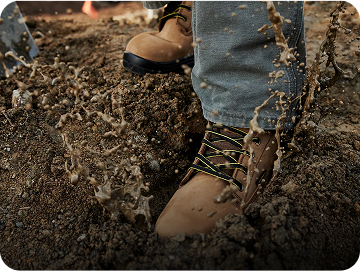Yes, a pair of work boots is bound to get beaten up, but that shouldn’t stop you from doing your best to keep them in tip top shape. Repairing scuffs and scratches should be part of your regular maintenance routine. And why wouldn’t it be? A good looking pair of boots can be worn almost anywhere, and with proper maintenance, for many years.
Repairing Material Transfer Scuffs
A material transfer scuff occurs when a foreign object rubs off on the surface of the leather, leaving behind a residual mark. These are pretty easy to get rid of since the damage sits on top of the leather rather than actually scratching it.
To get rid of them, simply remove the debris using a shoe brush or a pencil eraser. You don’t have to use a lot of pressure here.
If the scuff still holds up after brushing it, you can go in with a lightly abrasive wet sponge or a toothpaste & washcloth combo. Scrub the scuffed area with light, circular motions. Then leave it to dry.
Repairing Light/Medium Scuffs
These kinds of scuffs occur when the leather is actually damaged with light to medium abrasion. The damage can’t be undone, but if it isn’t too deep into the leather, it can be easily minimized and hidden with a leather conditioner.
Leather conditioners absorb into the leather, causing it to swell, and minimize the appearance of the damage. There are different types of conditioners from mink oil to synthetic treatments. For light scuffs, any kind of conditioner will do the trick. Just follow the instructions provided per the product, buff the afflicted area, and you’re done.
But if you’re dealing with heavier marks, you may want to go with something like lanolin cream. It’s a more potent treatment compared to any other leather oil. Simply follow the product’s instructions, buff off the scuffed area, and leave it to dry.
Repairing Deep Scratches
Scratches happen the same way scuffs do, they’re just much deeper. They can even go deep enough to tear the leather. If the scratch is deep enough that there’s a clear separation between two pieces of leather, it may be time for a new pair of shoes. While you can glue or sew them together, that’s merely a cosmetic fix as the outer layer of your boot has already been compromised.
But if you’re just dealing with a scratch, you’ll still be able to minimize its appearance, however it’s extremely difficult to hide it completely. You can start by conditioning and polishing the scratch. This should help to disguise it, although it will probably still be noticeable.
You can attempt to fill the scratch with glue or leather filler. These products artificially fill the gaps left by scratches and help create a smooth finish. Once the filler is applied, you will likely have to paint and polish the area to blend it in with the rest of the boot.
The downside for using fillers is that they’re likely to break down easily with wear. That being said, fillers could be more effective on a more stationary part of the boot compared to an area that is constantly flexed while walking. Otherwise, you may have to reapply filler every so often to maintain a smooth appearance.
In short, it is possible to repair damage to work boots. And it’s well worth it to maintain a pair of shoes that you’ll probably be wearing for many years to come. In the event that a scratch is too deep to completely conceal, it may be best to embrace the imperfection. Scuffs and scratches, while they may not always be the best looking, can definitely add character to a pair of leather work boots.
Learn more about the styles and features of EVER BOOTS products here.










Leave a comment